Landmine Monitor 2015
Mine Action
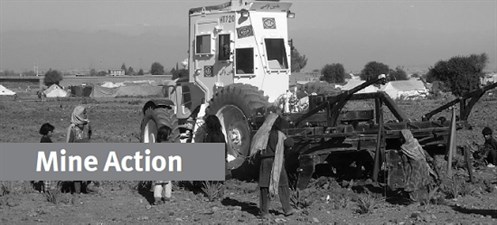
© HALO Trust, December 2014
Curious children look over an armored tractor with rotary mine comb safely parked in the Gulan refugee camp, Khost province, Afghanistan.
Progress continues to be made in removing the threat of antipersonnel mines. The amount of land reported to be cleared of landmines globally in 2014 increased to 201km2, compared to 185km2 in 2013. Twenty-eight States Parties have completed clearance since 1999. However, progress is slow. As few as three of the 33 States Parties with Article 5 clearance obligations are on track to meet their deadlines, even though in many cases this should be achievable. Improvements are needed in defining the size of the remaining antipersonnel mine contamination, reporting on survey and clearance results, and the timeliness and quality of extension requests.
Status and Key Developments 2014–2015[1]
- Sixty-one states and areas have an identified threat of antipersonnel mine contamination: 33 States Parties, 24 states not party, and four other areas. A further five States Parties have either suspected or residual mine contamination.
- In its initial Article 7 transparency report, Oman declared for the first time that it has areas suspected of being contaminated with antipersonnel mines, and therefore has been added to the list of contaminated States Parties. New antipersonnel mine contamination arising in Ukraine has resulted in it being added to the list of contaminated States Parties.
- A total of 201km2 was reported to be cleared of landmines in 2014, an increase from an estimated 185km2 in 2013. The total number of antipersonnel mines reported to be destroyed was 232,000, a decrease from 275,000 in 2013. Last year, the ICBL stated that it believed that more than 200km2 of mined area could be cleared annually, and in 2014 this was achieved.[2]
- Twenty-eight States Parties have completed implementation of Article 5 since 1999.[3] Burundi announced in April 2014 that it had completed survey and clearance of its remaining suspected mined areas and reiterated this announcement in June 2014. In September 2015, Mozambique declared itself clear of antipersonnel mines.[4]
- Twenty-seven States Parties have requested and received extended deadlines for clearance. In 2014, four States Parties submitted extension requests, all of which were approved at the third review conference: the Democratic Republic of Congo (DR Congo), Eritrea, Yemen, and Zimbabwe. In 2015, four states submitted extension requests for consideration by the 14th Meeting of States Parties, 30 November to 4 December 2015: Cyprus, Ethiopia, Mauritania, and Senegal.
- Only three States Parties appear to be on track to meet their Article 5 clearance deadline.
Mine Contamination in 2014
It is not possible to provide a global estimate of the total area contaminated by landmines due to a lack of data. Estimates of the size of contaminated areas have tended to be exaggerated as a result of poor surveys. However, global understanding of the scale of the problem is gradually improving each year, particularly among States Parties, as they make increased use of land release methodologies to cancel suspected hazardous areas (SHAs) by non-technical survey, and reduce confirmed hazardous areas (CHAs) through technical survey. No estimate of the size of contamination exists for seven States Parties, 18 states not party, and one other area, which are known to be contaminated (for further details of the estimated extent of antipersonnel mine contamination, please see the Mine Action country profiles at www.the-monitor.org).
Estimated extent of mine contamination
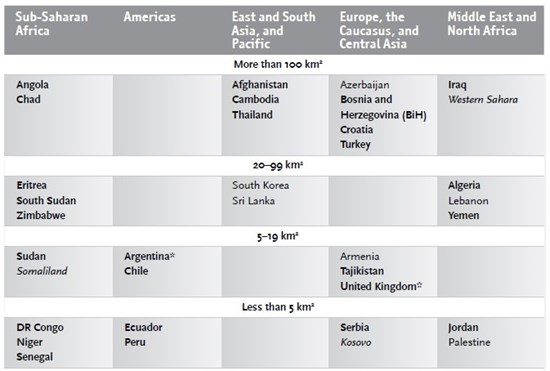

Note: States Parties to the Mine Ban Treaty are indicated in bold; other areas are indicated by italics.
*Argentina and the United Kingdom both claim sovereignty over the Falkland Islands/Malvinas, which still contain mined areas.
**Cyprus states that no minefields remain under Cypriot control.
***The known area in Georgia is small, but there may be mined areas in South Ossetia.
****The known area in Nagorno-Karabakh is small, but that estimate is believed to only include contamination within the Soviet-era boundaries of Nagorno-Karabakh, and not mine contamination in the adjacent territories.
Prior to 2014, Ukraine did not report any mine contamination under Article 5, as the scope of any residual mine problem it had was not known. In 2014, new contamination was reported in Ukraine and in a number of other states that were already contaminated (for details please see the Ban Policy chapter of this publication).
Five States Parties have residual or suspected contamination: Djibouti,[5] Moldova,[6] Namibia,[7] Palau,[8] and the Philippines.[9] These States Parties have an obligation to make “every effort” to identify mined areas under their jurisdiction or control that contain antipersonnel mines and then to clear any that they find. In cases where they are unable to complete this work within their Article 5 deadline, they must request an extension in order to remain in compliance with the treaty.
Mine Clearance in 2014
Total global clearance of landmines in 2014 was estimated to be 201km2, with 232,000 antipersonnel mines and 11,500 antivehicle mines destroyed. This represents an increase from 185km2 of total area cleared in 2013, although a decrease from the destruction of approximately 275,000 antipersonnel mines.
Ten countries comprised three-quarters of all reported clearance efforts in 2014. However, in three of these countries, there were substantial inconsistencies between data sources in reported areas cleared. Many states do not report on clearance, therefore this total figure is intentionally conservative and understates the extent of clearance.
Programs clearing the largest amount of mined area in 2014
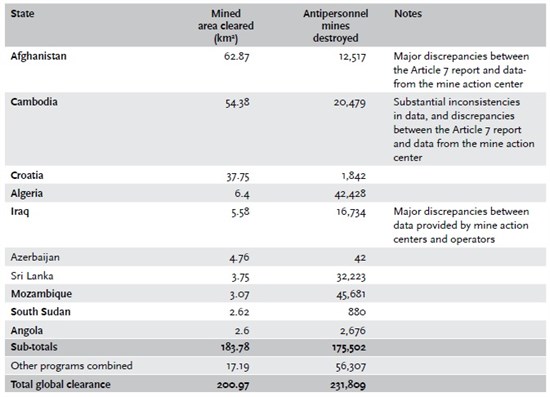
Note: States Parties to the Mine Ban Treaty are indicated in bold.
Five of the 10 most contaminated States Parties do not appear in the table above. Four of these states—BiH, Thailand, Turkey, and Zimbabwe—had low rates of clearance in 2014, ranging from 0.15km2 to 1.85km2, while Chad did not report on the amount of land cleared.
No clearance figures were reported in 2014 for the following States Parties: Chad, Eritrea, Ethiopia, Senegal, and Ukraine. Clearance was not reported in the following states not party: China, Cuba, India, Iran, Kyrgyzstan, Lao PDR, Libya, Myanmar, North Korea, Pakistan, Russia, South Korea, Syria, Uzbekistan, and Vietnam. Egypt and Morocco reported very high clearance figures, but provided no further details, therefore those figures have not been included in the total global clearance figure.
Mine clearance in 2010–2014 (km2)
|
Year |
Mined area cleared |
Antipersonnel mines destroyed |
Antivehicle mines destroyed |
|
2014 |
201 |
231,708 |
11,500 |
|
2013 |
185 |
275,000 |
4,500 |
|
2012 |
200 |
240,000 |
9,300 |
|
2011 |
190 |
325,000 |
29,900 |
|
2010 |
200 |
388,000 |
27,000 |
|
Total |
976 |
1,479,708 |
82,200 |
Mine Ban Treaty Article 5 Obligations
Under Article 5 of the Mine Ban Treaty, States Parties are required to clear all antipersonnel mines as soon as possible, but not later than 10 years after becoming party to the treaty. States Parties that consider themselves unable to complete their mine clearance obligations within the deadline may submit a request for a deadline extension of up to 10 years.
Completion of Article 5 implementation
Twenty-eight States Parties, one state not party, and one other area have completed clearance since the treaty entered into force in 1999. Burundi, which had reported additional suspected mined areas after declaring completion of its Article 5 obligations in 2011, announced that its subsequent survey and clearance efforts in 2014 had been completed.[10] Mozambique declared completion of its Article 5 obligations in September 2015.[11] However, because Mozambique had not requested an additional extension to its deadline of 1 January 2015, for eight months Mozambique was in violation of the Mine Ban Treaty. Montenegro has still formally to report completion of its Article 5 obligations.
State Parties that have completed Article 5 implementation since 1999
|
Albania |
France |
Honduras |
Rwanda |
|
Bhutan |
FYR Macedonia |
Hungary |
Suriname |
|
Bulgaria |
Gambia |
Malawi |
Swaziland |
|
Burundi |
Germany |
Montenegro |
Tunisia |
|
Congo |
Greece |
Mozambique |
Uganda |
|
Costa Rica |
Guatemala |
Nicaragua |
Venezuela |
|
Denmark |
Guinea-Bissau |
Nigeria |
Zambia |
In addition, state not party Nepal and other area Taiwan have completed clearance of known mined areas since 1999. El Salvador, a State Party, completed clearance in 1994, before the Mine Ban Treaty was created.
Progress on meeting deadlines
As of November 2015, only three States Parties are on track to meet their clearance deadlines, while 20 are not on track, and the status of three is unclear. Four States Parties are awaiting approval of their extension requests submitted in 2015. Two States Parties have missed their deadlines.
The assessments of the status of each States Party regarding the fulfilment of their Article 5 obligations are made through consideration of several factors including the deadline date, the remaining challenge and the extent to which it is known, clearance rates, mine action capacity and assets, funding prospects, and the existence of any conflict and insecurity problems.[12]
States Parties with outstanding Article 5 obligations, their deadlines, and status of any deadline extensions
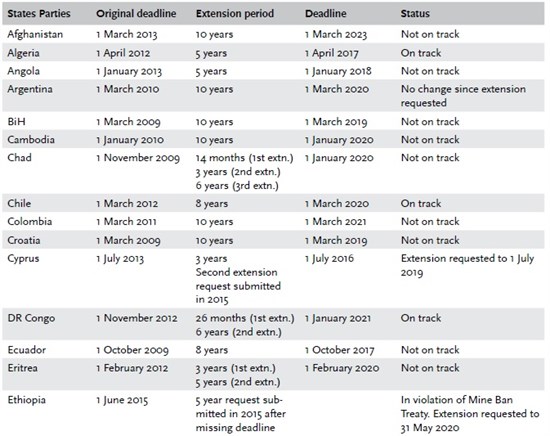
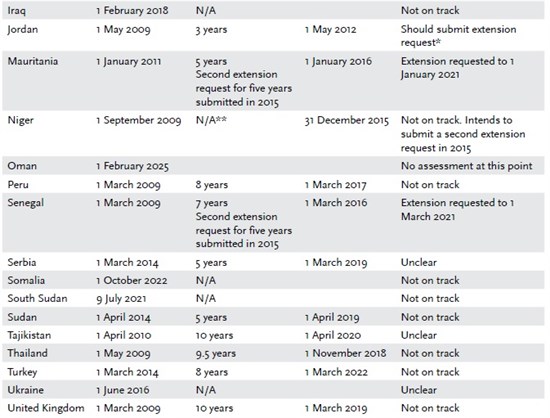

*Jordan formally declared completion of clearance at the Twelfth Meeting of States Parties in 2012. However, given Jordan’s recognition that it still has suspected hazardous areas, it has outstanding Article 5 obligations to fulfil, and should submit an extension request.
** Niger’s first extension request was granted in accordance with a procedure for mined areas discovered after the expiration of a state’s Article 5 deadline.
N/A = not applicable.
Four States Parties submitted extension requests that were approved at the Third Review Conference in June 2014:[13]
- DR Congo requested a six-year extension period to conduct non-technical and technical surveys and clearance in order to complete its obligations.[14] In granting DR Congo’s second extension request, States Parties called on DR Congo to present a detailed workplan by 30 April 2015. However, in June 2015 DR Congo informed States Parties that due to funding difficulties it was unable to submit a workplan until the next meeting of States Parties in December 2015.[15]
- Eritrea’s extension request sought a further five years to continue clearance and complete resurvey of SHAs, but not to fulfil its clearance obligations under the treaty. In granting the extension request, States Parties noted that five additional years beyond Eritrea’s previous February 2015 deadline “appeared to be a long period of time to meet this objective.”[16]
- Yemen’s second extension request acknowledged that it was largely “based on speculation,”[17] and operations in 2014 in fact fell well short of the extension request target of clearing 1.6km2 a year, hampered by insecurity and by an acute shortage of funds.
- Zimbabwe’s three-year extension request was to enable further survey and clearance, but not to complete its clearance obligations within the requested period. Zimbabwe undertook “to clarify the remaining challenge, understand what progress will be possible once partners operate at full capacity and once additional support has been identified, produce a detailed plan, and submit a subsequent request for fulfilment of its Article 5 obligations.”[18] In granting the request, States Parties stated that Zimbabwe had not complied with the principal commitment it made under previous extension requests “to garner an understanding of the true remaining extent of the challenge and to develop plans.” They noted the progress made toward building capacity and increasing efficiency by engaging support from international organizations.[19]
Four States Parties submitted extension requests in 2015 for approval at the 14th meeting of States Parties, to be held 30 November–4 December 2015:
- Cyprus submitted a second request on 27 March 2015, for a further three-year extension, until 1 July 2019. The reason cited for the second extension request was the same as the first request, namely that Cyprus does not have effective control over remaining contaminated areas.[20]
- Ethiopia is in violation of the Mine Ban Treaty for missing its 1 June 2015 clearance deadline, a situation that could have been avoided by accelerating progress in previous years or by requesting an extended deadline in 2014, as per the process agreed at the Seventh Meeting of States Parties. Ethiopia submitted a request on 15 June 2015 for an extension of five years until 1 June 2020 to complete survey and clearance of all remaining mined areas.[21] Ethiopia’s extension request contains a number of inconsistences and errors. The Committee on Article 5 Implementation therefore asked for clarification of several points, and a response was provided on 26 October 2015.
- Mauritania submitted an extension request in April 2015 because of suspected contamination on the border with the area of Western Sahara, in locations where border demarcation needs to be clarified. In its request for a second extension, up to 1 January 2021, the Mauritanian government said it would enter into a dialogue with “all of the stakeholders in the Western Sahara conflict so as to be in a position to clarify the status of the suspected areas.”[22]
- Senegal’s latest Article 5 deadline extension request submitted in June 2015 included plans for survey and clearance in 2016–2020, but did not specify how developments in peace discussions were expected to impact clearance, how the armed forces would be involved in the clearance process, or how resources would be mobilized.[23]
Niger announced in June 2015 that it would submit a second extension request which, as of 8 November 2015, has yet to be submitted.
Funding shortages have been cited as an impediment to fulfilling Mine Ban Treaty Article 5 obligations by or for approximately one-third of States Parties with outstanding obligations. Several of these states are also experiencing conflict or security problems that contribute to the lack of donor support. Conflict and security problems are reported to severely affect implementation in Afghanistan, Iraq, Senegal, Somalia, South Sudan, and Yemen. In the following countries, insecurity is reported to hamper land release efforts in specific geographical areas: Chad, Colombia, DR Congo, Ethiopia, Jordan, Thailand, and Turkey.
However, many of the States Parties that have requested extensions, or are not on track to meet their deadlines, are not facing such constraints. The Cartagena Action Plan adopted at the Second Review Conference in 2009 stated that extensions should only be needed “due to exceptional circumstances.”[24] Despite this, by November 2015, of the 33 States Parties with outstanding clearance obligations, 28 have requested deadline extensions, eight of which have requested extensions at least twice. The ICBL has called on States Parties to act with greater urgency in fulfilling their clearance obligations.[25]
Many of those States Parties with extended deadlines in place are making only limited progress, as the table above indicates. Moreover, many have not provided clear plans on how they intend to meet their clearance obligations within their deadlines. The Committee on Article 5 Implementation observed that of the “States Parties that are in the process of implementing Article 5, few have reported that they have a plan to complete implementation of Article 5, some have plans that extend beyond their deadlines and many have not indicated that they have plans leading up to their deadlines.”[26]
Monitoring the progress of States Parties against their Article 5 obligations and the Maputo Action Plan
The Maputo Action Plan was adopted at the Third Review Conference on 27 June 2014. Actions 8, 9, and 11 relate to clearance, and States Parties agreed to “commit to intensify their efforts to complete their respective time-bound obligations with the urgency that the completion work requires.”[27]
The Committee on Article 5 Implementation was established by the Third Review Conference, replacing the Standing Committee on Mine Action.[28] Its purpose is to “intensify efforts, particularly those outlined in the Maputo Action Plan, to ensure that Article 5 is fully implemented as soon as possible, while acknowledging local, national and regional circumstances in its practical implementation.” It also analyzes each request for an Article 5 extended deadline. It presented its preliminary observations on Article 5 implementation on 23 June 2015, reporting on 16 of the 18 States Parties that had submitted information by that date.[29]
With regard to Maputo Action Plan Action #8 (quantification and qualification of remaining contamination challenge), the Committee assessed the degree of clarity of the remaining challenge, finding that only four of the 16 States Parties had provided a high degree of clarity: Afghanistan, Ecuador, Sudan, and Thailand.
In assessing Maputo Action Plan Action #9 (application of land release methodologies), the Committee called on States Parties to align their national mine action standards with the revised International Mine Action Standards (IMAS) if they have not already done so.
Maputo Action Plan Action #11 calls for on-time submission of high-quality requests. In 2015, two states submitted on-time requests (Cyprus and Mauritania), while Ethiopia and Senegal missed the submission deadline by more than 15 months and 2.5 months respectively. One state announced its intention to submit a request that has still not been made public as of 8 November 2015 (Niger). The requests prepared by Ethiopia and Senegal lacked the consistency, accuracy, and comprehensiveness that would characterize high-quality requests.
As of 1 November 2015, Article 7 transparency reports for 2014 were still outstanding for eight states with contamination: Angola, DR Congo, Eritrea, Ethiopia, Niger, Senegal, Somalia, and Yemen. Maputo Action Plan Action #25 calls for the annual submission of high-quality and updated information.
[1] The Monitor acknowledges the contributions of Norwegian People’s Aid (NPA), which conducted the majority of mine action research performed in 2015 and shared it with the Monitor. The Monitor is responsible for the findings presented here.
[2]Landmine Monitor 2014, Mine Action chapter, p. 21.
[3] In addition, El Salvador completed clearance in 1994, before the Mine Ban Treaty was created. Jordan declared completion of clearance in April 2012 but has found hundreds of antipersonnel mines during subsequent verification and clearance operations; it therefore still has an obligation under Article 5.
[4] In a public ceremony, Foreign Affairs and Cooperation Minister Oldemiro Baloi declared the country to be free of the “threat” of mines. UNDP in Mozambique, “Mozambique declared ‘mine free,’” undated, www.mz.undp.org/content/mozambique/en/home/ourwork/environmentandenergy/successstories/Mozambique_Declared_Mine_free/. An email from Hans Risser, UNDP, 13 October 2015 stated that following its announcement of completing the last antipersonnel mine clearance task on its territory in September 2015, Mozambique was expected to make a formal declaration of compliance with its Mine Ban Treaty Article 5 obligations and submit a report to the Article 5 Committee at the next Meeting of States Parties in December 2015. Burundi had declared completion in November 2011 but subsequently discovered additional areas requiring clearance, and cleared those prior to its deadline. Statement of Burundi, Mine Ban Treaty Third Review Conference, 26 June 2014, www.maputoreviewconference.org/fileadmin/APMBC-RC3/thursday/13_HIGH_LEVEL_SEGMENT_-_Burundi.pdf.
[5] Djibouti completed its clearance of known mined areas in 2003 and France declared it had cleared a military ammunition storage area in Djibouti in November 2008, but there are concerns that there may be mine contamination along the Eritrean border following a border conflict between Djibouti and Eritrea in June 2008. Djibouti has not made a formal declaration of full compliance with its Article 5 obligations.
[6] Moldova, which had an Article 5 deadline of 1 March 2011, made a statement in June 2008 that suggested it had acknowledged its legal responsibility for clearance of any mined areas in the breakaway republic of Transnistria, where it continues to assert its jurisdiction. However, this statement was later disavowed by the Ministry of Foreign Affairs, www.apminebanconvention.org/fileadmin/APMBC/IWP/SC_june08/Speeches-GS/SCGS-Universalization-2June08-Moldova-en.pdf.
[7] Despite a statement by Namibia given at the Second Review Conference that it was in full compliance with Article 5, questions remain as to whether there are mined areas in the north of the country, for example in the Caprivi region bordering Angola.
[8] Palau submitted an Article 7 report in 2011 in which it declared for the first time that it had areas containing antipersonnel mines on its territory. In its 2012 Article 7 report, Palau reported suspected contamination in the Umubrogol Mountains (on Bloody Nose Ridge). In May 2013, Palau reported that two mine clearance operators were working in Palau to clear unexploded ordnance, including land and sea mines, but that it faced a “bottle neck from the government permitting bodies due to lack of Standard Operating Procedures and the technical knowledge to review and approve clearance methodologies.”
[9] The Philippines, which has alleged use of antipersonnel mines by non-state armed groups over recent years, has not formally reported the presence of mined areas.
[10] Statement of Burundi, Mine Ban Treaty Third Review Conference, 26 June 2014, www.maputoreviewconference.org/fileadmin/APMBC-RC3/thursday/13_HIGH_LEVEL_SEGMENT_-_Burundi.pdf
[11] In a public ceremony, Foreign Affairs and Cooperation Minister Oldemiro Baloi declared the country to be free of the “threat” of mines. UNDP in Mozambique, “Mozambique declared ‘mine free,’” undated, www.mz.undp.org/content/mozambique/en/home/ourwork/environmentandenergy/successstories/Mozambique_Declared_Mine_free/. An email from Hans Risser, UNDP, 13 October 2015 stated that following its announcement of completing the last antipersonnel mine clearance task on its territory in September 2015, Mozambique was expected to make a formal declaration of compliance with its Mine Ban Treaty Article 5 obligations and submit a report to the Article 5 Committee at the next Meeting of States Parties in December 2015.
[12] The status assessments were made by NPA, and the Monitor concurs with these conclusions.
[13] APLC/CONF/2014/CRP.1, Final Draft Document, Mine Ban Treaty Third Review Conference, 27 June 2014, pp. 6–10, www.maputoreviewconference.org/fileadmin/APMBC-RC3/3RC-Final-report-Jun2014.pdf.
[14] Analysis of DR Congo’s Article 5 deadline Extension Request, submitted by the President of the Mine Ban Treaty Third Review Conference on behalf of the States Parties mandated to analyse requests for extensions, 18 June 2014, p. 5.
[15] Statement of DR Congo, Mine Ban Treaty Intersessional Meetings, Standing Committee on Article 5 Implementation Matters, Geneva, 25 June 2015.
[16] Decision on the Eritrea Article 5 deadline Extension Request, submitted by the President of the Mine Ban Treaty Third Review Conference, Maputo, 26 June 2014.
[17] Second Mine Ban Treaty Article 5 deadline Extension Request, 17 December 2013, p. 15.
[18] Decision on Zimbabwe’s Article 5 deadline Extension Request, Mine Ban Treaty Third Review Conference, Maputo, 26 June 2014.
[19] Ibid.
[20] Second Mine Ban Treaty Article 5 deadline Extension Request, 27 March 2015.
[21] Mine Ban Treaty Article 5 deadline Extension Request, 31 March 2015, p. 10.
[22] Mine Ban Treaty Second Article 5 deadline Extension Request, 2 April 2015, p. 4.
[23] Mine Ban Treaty Article 5 deadline Extension Request, June 2015, p. 28.
[24] “Cartagena Action Plan 200-2014: Ending the Suffering Caused by Anti-Personnel Mines,” 11 December 2009, p. 4, www.cartagenasummit.org/fileadmin/APMBC-RC2/2RC-ActionPlanFINAL-UNOFFICIAL-11Dec2009.pdf.
[25] See for example ICBL, Statement on Clearance, Third Review Conference of the Mine Ban Treaty, 24 June 2014, icbl.org/media/1466485/icbl-3rc-statement-on-clearance.pdf.
[26] Preliminary Observations of the Committee on Article 5 Implementation, 23 June 2015, p. 4, www.apminebanconvention.org/fileadmin/APMBC/IWP/IM-June15/IM-June2014-Preliminary_observations-Art5.pdf.
[27] Maputo Action Plan, 27 June 2014, www.maputoreviewconference.org/fileadmin/APMBC-RC3/3RC-Maputo-action-plan-adopted-27Jun2014.pdf.
[28] Draft Final Document, 27 June 2014, www.maputoreviewconference.org/fileadmin/APMBC-RC3/3RC-Final-report-Jun2014.pdf.
[29] Preliminary Observations of the Committee on Article 5 Implementation, 23 June 2015, www.apminebanconvention.org/fileadmin/APMBC/IWP/IM-June15/IM-June2014-Preliminary_observations-Art5.pdf.

